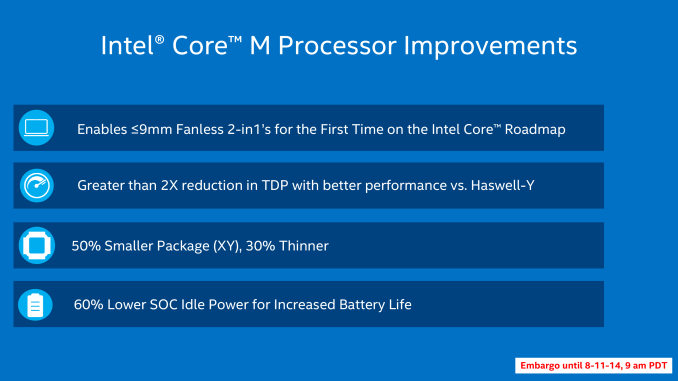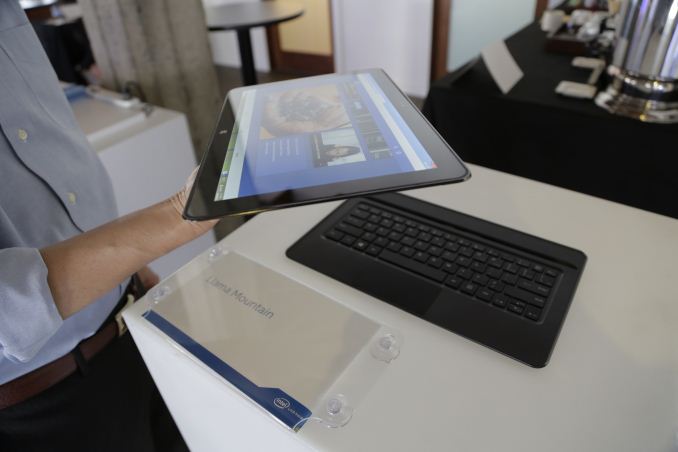Intel Broadwell Architecture Preview: A Glimpse into Core M
by Ryan Smith on August 11, 2014 12:01 PM ESTClosing Thoughts
Wrapping up our preview of the Broadwell architecture and Intel’s Core M processor, the bulk of Intel’s presentation and focus today is on the latter, so that is where we’ll start.
Core M is not a make-or-break product for Intel, but none the less it is a very important one. Mobile devices – be it tablets, slates, transformers, 2-in-1s etc – are continuing to increase in popularity, and as we’ve seen with ARM based tablets so far they form a market that has continued to grow and continued to erode the x86 laptop market that Intel has dominated for so long. Though laptops as a category are not going anywhere any time soon, their erosion means that Intel needs to get into mobile devices if they want to maintain their sales and their stature. To that end it’s not too late for Intel to break into this market and turn things around, but if they’re going to succeed then they need to make their move sooner or later, and this is where Core M fits in.
It’s telling then that while Intel is going after this market with a Core architecture, they are doing so under a different Core brand. Core M doesn’t just represent a new low powered Core CPU, but in Intel’s eyes is another product entirely. One that is so different that it does away with the Core i3/i5/i7 convention entirely and gets its own brand name and own product numbers. Core M is still Core, but it is nearly unrecognizable compared to the Core of even 4 years ago.
As far as the Core M product is concerned then, while Intel’s plans are grand they are not without merit. Backed by Intel’s new 14nm process and the Broadwell architecture, Core M looks like it should finally resolve the issues that dogged even Haswell-Y by bringing down power consumption even further while improving on Intel’s already strong performance, and getting the resulting processor in an SoC small enough to be usable in even the thinnest mobile devices. In fact from a technical perspective there’s little reason to doubt Core M; we’ll still have to wait to see just how good the resulting retail products are, but there shouldn’t be any technical reason for why it can’t be put into a mobile device comparable to today’s 10”+ tablets. Intel’s own Llama Mountain reference design can vouch for that much, showcasing the viability of Core M in a 12.5” tablet that’s just 7.2mm thick.
Intel's Llama Mountain, a Core M form factor reference design
More likely what will determine Core M’s fate and Intel’s ability to completely break into the mobile device market will be pricing. Intel’s profit margins are somewhat legendary in the computer industry, and a big part of that profitability has come from the high prices Intel has enjoyed from products such as their Core processors. Core M, like the other Cores before it, will still be an upscale product – a higher priced, higher performance alternative to Intel’s mass-market Atom processors. And while that makes plenty of sense on paper, in the real world Intel has to face the AllWinners and other ARM vendors of the world who are happy to sell their ARM SoCs at significantly lower margins, which can have a knock-on effect even if they can’t compete with Intel on overall performance. At this point it’s far too early to call this, especially when Intel isn’t even discussing Core M pricing at this time, but it’s a subject that Intel will have to consider carefully as “good enough” ARM devices will continue to be the biggest threat to Intel’s position in the CPU market.
Moving on, while today’s release from Intel only offers us a preview of what Intel will be delivering with their Broadwell architecture, what Intel has presented thus far looks to continue Intel’s tradition of relentless execution. As a tick Broadwell is a small but respectable improvement in Intel’s Core architecture, with the expected 5% IPC improvement in-line with previous ticks. For more traditional desktops and laptops it won’t radically change the world, but then it never was meant to. The biggest question for these parts will be whether Broadwell will improve on Haswell’s clockspeeds at all – a clockspeed boost made possible by Intel’s 14nm process – or if we’re going to hold steady similar to what we saw with the last tick, Ivy Bridge.
Meanwhile Broadwell’s GPU improvements are more significant, and in the race to further improve what’s essentially the baseline for PC GPU performance it is always welcome. Furthermore the fact that Intel is now at API feature parity with discrete GPUs is a big deal for Intel and it is a big deal for iGPUs as a whole. What we still want to see is more performance; a single slice seems just about right for Core M, but if we’re talking about larger laptop and desktop parts it would be very nice to see something akin to GT3 become baseline, especially with the die size savings Intel will be seeing from the 14nm process.
Finally, from here the rest of Intel’s 2014 should be rather busy. Next month is Intel’s Fall IDF 2014, at which point we expect we’ll be given a deeper look at Broadwell’s architecture. Past that the first Broadwell-Y based Core M processors will be on the shelves for the holidays, and with it our chance to see Broadwell and Intel’s 14nm process in action. However that will also be our only chance to see Broadwell in action this year; while Core M will ship in time for the holidays, the rest of the Broadwell lineup will not appear until 2015.













158 Comments
View All Comments
kyuu - Tuesday, August 12, 2014 - link
Nothing was said about cheap tablets in that quote, so I'm not sure why you're bringing up the price.Not that I disagree with your point. Of course, by continuing to focus on premium priced parts, Intel is never going to gain a profitable foothold in the mobile market. Core M needs to be cheaper, not just lower power, to be interesting. Otherwise there's no reason to care. If you're paying for a $1000 device, why do you want something that's obviously going to be so performance gimped compared to Y-series Broadwells?
Drazick - Tuesday, August 12, 2014 - link
Does "Shared Virtual Memory" means the same as AMD's shared memory configuration?No more need to replicate data for the GPU?
Laststop311 - Tuesday, August 12, 2014 - link
A surface Pro with core-M might be pretty good.Krysto - Tuesday, August 12, 2014 - link
For battery life, maybe. For performance, no.fokka - Tuesday, August 12, 2014 - link
i would like to see ordinary 13" ultrabooks with broadwell-y. don't make it too slim and see what performance and battery life is like with a 4.5w cpu. if performance is high enough for everyday tasks, it would really be nice to have slim notebooks approach 20 hours of battery life in light usage scenarios.but i guess companies will just use the low power cpus as an excuse to implement smaller batteries and 4k displays and we still won't get much more than 10h in best case scenarios...
dcaxax - Tuesday, August 12, 2014 - link
I'd argue that it may well be too late for Intel to enter this market, unless they can deliver a major step change in performance compared to ARM. Right now the ARM-Android & ARM-iOS ecosystems are well established and humming along nicely. On top of which tablet sales in the developed world are slowing down. The developing world is still growing but in those regions, cost will be a key factor.That leaves Intel targeting a market with an entrenched competitor, a set software ecosystems with no benefits from migrating to a new architecture (what do Apple, Google, Samsung, HTC, LG etc gain out of this?) and slowing hardware sales.
I Core M can deliver double performance for the same power draw AND price, then sure, I can see a rush to migrate to it, otherwise what's the point?
Krysto - Tuesday, August 12, 2014 - link
"Core" chips will never EVER compete with ARM in its main market. The best Intel can do is try to compete in $700+ devices. Core is just not competitive on price. Not even close. Period.Intel's only competition against ARM in the MOBILE market is Atom, and Nvidia's Denver is already TWICE as fast as that. Also Atom is twice as expensive as Denver, but Intel keeps subsidizing half the cost...for as long as they can, which probably won't be much longer.
tuxRoller - Wednesday, August 13, 2014 - link
Link to the denver benchmarks?Natfly - Tuesday, August 12, 2014 - link
This article feels like marketing drivel just listing point after point without any further explanation. I'd expect a little more in-depth analysis. Seriously a tick/tock chart?KhalidShaikh - Tuesday, August 12, 2014 - link
Great write up.